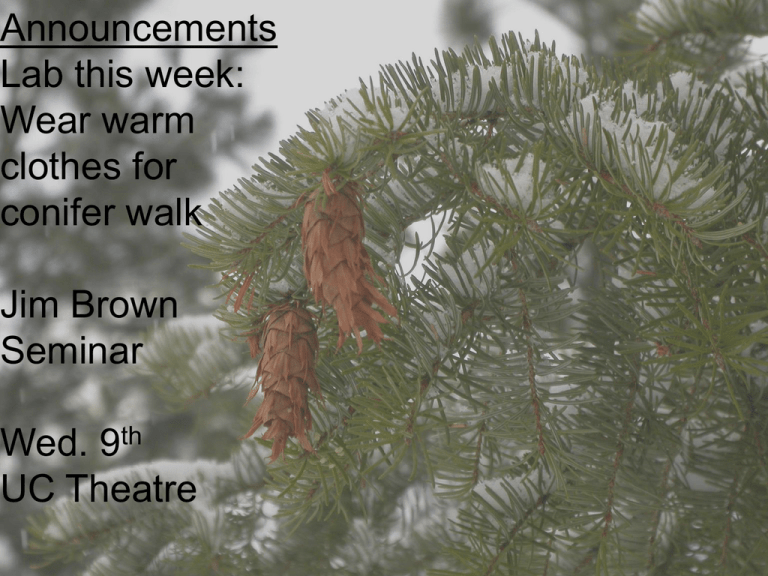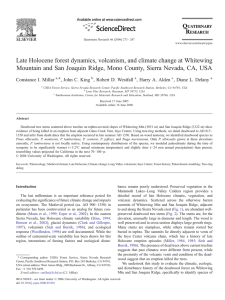Pinaceae (Pine Family)
advertisement

Announcements Lab this week: Wear warm clothes for conifer walk Jim Brown Seminar Wed. 9th UC Theatre Coniferales (Conifers) 5 families worldwide, 3 in Montana Pinaceae - Pine Family Cupressaceae - Cypress Family Taxaceae - Yew Family Conifers - Pinaceae (Pine Family) Pinus - Pine Larix - Larch or Tamarack Pseudotsuga - Douglas Fir Abies - Fir Tsuga - Hemlock Picea - Spruce Larix - Larch Key features Deciduous needles in clusters Small cones w/ 3-parted bracts P. monticola L. occidentalis Western Larch L. lyallii Subalpine Larch P. albicaulis Tsuga - Hemlock P. albicaulis T. heterophylla (coastal disjunct) Pseudotsuga menziesii - Douglas-fir P. monticola P. albicaulis Abies - Fir Key features Blunt evergreen needles Barrel-shaped cones held upright Cone scales dehisce (fall off) P. monticola P. albicaulis A. lasiocarpa Subalpine Fir A. grandis Grand Fir P. monticola P. albicaulis Key features Picea - Spruce Sharp needles Papery cones hang down P. monticola twig w/ pegs scaley bark P. albicaulis P. engelmannii Engelmann Spruce P. glauca White Spruce P. monticola P. albicaulis Conifers - Pinaceae (Pine Family) Pinus - Pine Larix - Larch or Tamarack Pseudotsuga - Douglas Fir Abies - Fir Tsuga - Hemlock Picea - Spruce Cupressaceae - Cypress Family Key features Leaves usually scale-like (folded and flattened) Female cones small, either woody or “berry-like” Two genera in Montana Thuja (large trees) Juniperus (small trees or shrubs) Thuja plicata - Western Red Cedar Coastal disjunct found on moister western slopes in Rockies Female cones Juniperus - Juniper Dioecious shrubs/small trees Female cones berry-like J. communis Common Juniper low shrub w/needles worldwide distribution J. scopulorum Rocky Mtn. Juniper shrub/small tree scale leaves Taxaceae - Yew Family Key features Dioecious shrubs/small trees Needles flattened; appear 2-ranked No cone - seed surrounded by a fleshy aril One genus/species in Montana (Taxus brevifolia) Taxus brevifolia - Pacific Yew Papery bark Coastal disjunct only in moist areas here (canyons etc.) Arils (only on females) Conifer Questions???? Pinaceae - Pine Family Cupressaceae - Cypress Family Taxaceae - Yew Family Moving on to angiosperms: the vast majority of plants Seed plants ~135 mya Ephedra Conifers Gingkos Cycads Angiosperms 600 species 257,000 species Plant life histories Different means to the same end: survival & reproduction Lifespan and timing of reproduction Ideal plant strategy: 1) live forever 2) make lots of seeds every year Why not? Lifespan and timing of reproduction Ideal plant strategy: 1) live forever 2) make lots of seeds every year Why not? Limited resources (light, nutrients, water etc.) tradeoff between survival/growth and reproduction (usually...) Lifespan and timing of reproduction Life history strategies high adult mortality --> reproduce now! ex. weeds, vernal pool plants high seedling mortality --> just survive! ex. trees, grassland forbs Lifespan and timing of reproduction: herbs (woody trees and shrubs are all perennial by definition) Mimulus douglasii Oenothera biennis Balsamorhiza and Lupinus Annual Biennial Perennial 1st year: flowers, dies 1st year: makes rosette 2nd year: flowers, dies Lives for multiple years May or may not flower in any year Lifespan and timing of reproduction iteroparity - reproduce repeatedly etc. semelparity- reproduce once, then die Lifespan and timing of reproduction Agave (Century Plant) extreme semelparity Plants are sessile and modular vs. Some consequences of being a plant • can make own food (photosynthesis) • can grow indefinitely & survive major damage BUT, can’t go look for a better place local competition for resources evolution of fungal/bacterial symbioses evolution of seed dispersal mechanisms can’t go look for mates evolution of pollination mechanisms Competition for light affects plant growth form over evolutionary time over individual lifespans terminal (apical) bud Angiosperm vegetative terminology internode axillary bud leaf! node stem terminal (apical) bud Angiosperm vegetative terminology internode axillary bud leaf! node stem or shoot opposite leaves alternate whorled Cauline leaves (on shoot) Angiosperm vegetative terminology Basal leaves (at base of shoot) Leaf parts Leaf venation margin midvein dichotomous pinnate blade petiole stipule palmate parallel Plant water relations Leaves need to uptake gas (CO2) for photosynthesis, but also need to minimize loss of H2O through leaves mesophyll w/chloroplasts vein w/vascular tissue (water , sugar ) waxy cuticle (blocks water loss) stoma w/guard cells (regulates gas exchange) Succulents (modified for water storage) Sagebrush foliage - Adaptation to dry/high sun conditions Artemisia tridentata (Asteraceae) Leaf forms Leaf margins entire dentate simple unlobed compound (palmate) simple lobed compound (pinnate) simple lobed (palmate) compound (twice pinnate) How to figure out what is the leaf axillary bud is always at base of leaf (above the petiole) Roots anchoring water and nutrient absorption water and carbohydrate storage Taproot Fibrous roots Adventitious roots Storage roots ? Modified stems rhizome = horizontal, rootlike stem shoot buds rhizome stem roots tuber (extra-starchy rhizome) Modified stems stolon = an aboveground horizontal stem with long internodes Fragaria Saxifraga plantlets Fragaria Saxifraga Asexual or clonal reproduction Modularity => a continuum between growth and reproduction Fragaria Saxifraga Definition of “individual” depends on perspective genetic individual --> “genet” growth unit --> “ramet” Saxifraga Populus tremuloides (Aspen)










